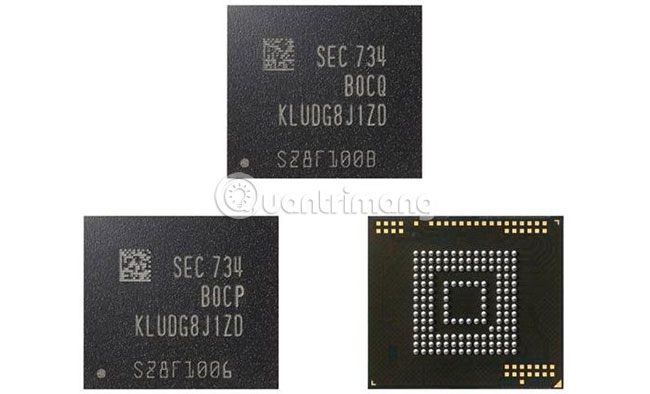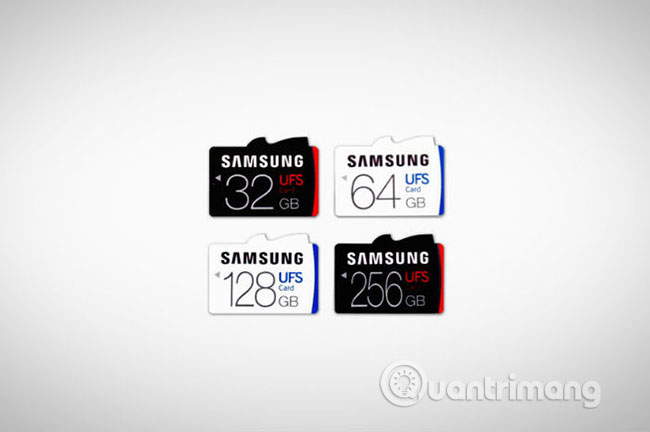Learn about UFS 3.0
In the past decade, smart phone technology has undergone major improvements and changes. In the past, there was a time when the phone did not have a camera. Today, there are at least three camera modules on one phone, all with different functions and zoom levels. But have you ever thought about what's going on in the memory of your smartphone, tablet or digital camera? For most people, this is not something to worry about until the storage capacity runs out.
Fortunately, this important component performance is also improving, similar to charging techniques. Today, high-end smartphone models have run Universal Flash Storage (UFS) standard.
So what is UFS? What is the latest version of UFS? What are the benefits of UFS 3.0? The following article will explain why this standard is important, how it can significantly increase battery life and improve speed in the future.
What is UFS?
UFS is a storage standard designed to provide ultra-fast read and write speeds for smartphones and digital cameras, consuming less power in the process. You can feel the benefits of UFS when you take photos, record videos or access data on your device's internal memory, as you will enjoy fairly fast speed and longer battery life.
 Learn about UFS 3.0 Picture 1
Learn about UFS 3.0 Picture 1
Finally, UFS seeks to replace the eMMC flash memory (embedded MultiMedia Card) available in many cameras, smartphones and tablets. UFS is much faster than eMMC memory, in part because of the way information is exchanged with the main device.
Conventional embedded flash solutions and flash-based memory cards handle each instruction, limiting random read / write access performance. However, UFS has a faster read / write speed and faster sequence because it accepts SCSI Architecture Model and SCSI Tagged Queuing, so it can send multiple requests simultaneously to the storage.
UFS has variants like removable cards that are similar to microSD or eUFS memory cards. The second type, eUFS, was first applied by Samsung Galaxy S6 and can be found on many Android flagship, as well as many of Samsung's later high-end devices.
 Learn about UFS 3.0 Picture 2
Learn about UFS 3.0 Picture 2
What is UFS 3.0?
In January 2018, JEDEC disclosed UFS 3.0 standards to increase bandwidth and double the transfer rate, while minimizing energy demand on the system. More than a year later, this new storage standard really resonates with the release of OnePlus 7 Pro.
UFS 3.0 is like SSD technology for phones and digital cameras, not listed with other specifications but can greatly affect device performance. UFS 3.0 is much faster than UFS 2.1 and very much compared to other memory standards like eMMC. UFS 3.0 allows super speeds up to 23.2Gbps, while reducing power consumption. This means that you can even shoot 4K or 8K videos at a higher frame rate without having a problem with your handset.
Benefits of UFS 3.0
UFS 3.0 offers several benefits including:
- Read / write speed is faster, significantly improves multitasking
- Lower power consumption
- Longer battery life
- Improve the user experience
Although UFS 3.0 provides flexible read and write speeds, what this means depends on what you do with your smartphone. Everyone likes apps, as well as their games are saved and loaded quickly. Similarly, with 4K video recording becoming more popular and 8K also beginning to appear, UFS 3.0 will prove useful, although you may not need it at the moment.
So far, very few flagship phones like Samsung Galaxy Fold, One Plus 7 and OnePlus 7 Pro support UFS 3.0. It will take some time for UFS 3.0 to be popular on mid-range phones. Hopefully the great potential of UFS 3.0 will be seen when smartphones grow stronger, the network becomes more reliable and fast.
You should read it
- Samsung's new memory chip incorporates EUFS 3.0 technology, recording speed of 2100MB / s, copying Full HD movies in just 3 seconds
- Samsung began mass-producing the world's 'fastest memory' for smartphones
- China's memory chip production will go from zero to 5% of the world by the end of next year
- LPDDR5 8GB DRAM memory chip first for smartphones with a speed of 6,400 Mb / s
- Samsung will launch a 1TB memory chip for smartphones, will it appear on Galaxy S10?
- Apple is in talks with Chinese companies to supply memory chips for the iPhone
- Package-on-Package technology: Reduce cellphone size
- Samsung is ready to pump an additional $ 116 billion for the battle in the mobile chip market
- Samsung started manufacturing Aquabolt: 2.4G Gb DRM speed 8GB 2.4Mb / sec
- The difference between H1 chip and Apple W1 chip
- How does ROM memory work?
- How to determine if computer memory has a problem?






 7 simple tips to help you learn new languages in just one week
7 simple tips to help you learn new languages in just one week The secret to effective language learning from a 35-year-old man who speaks 11 languages
The secret to effective language learning from a 35-year-old man who speaks 11 languages How to learn English for free with Vndoc, from basic to advanced
How to learn English for free with Vndoc, from basic to advanced 7 best websites to help kids learn about AI and Machine Learning
7 best websites to help kids learn about AI and Machine Learning 8 reasons you should learn to say 'NO' now
8 reasons you should learn to say 'NO' now There is a generation of children who learn to write code before they can talk to people in India
There is a generation of children who learn to write code before they can talk to people in India